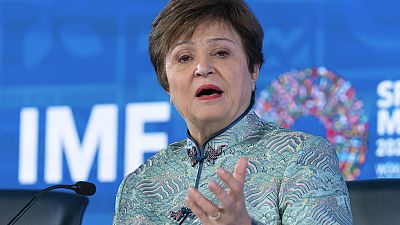While new figures confirm economic stagnation in the EU at the end of last year, eyes turn to predictions from Bank of America that the ECB will cut interest rates in June.
Economic activity in both the euro area and the European Union experienced stagnation in the last quarter of 2023, according to new data.
Eurostat's third estimates released on Friday show that Denmark led with a notable GDP increase of 2.0%, trailed by Croatia at 1.3%, and Slovenia at 1.1%.
On the flip side, Ireland experienced the most significant decline at -3.4%, followed by Estonia and Finland, both at -0.7%.
Excluding the 0.1% growth witnessed in the second quarter of 2023, real economic activity in the euro area has been largely stagnant since the third quarter of 2022 when it grew by 0.5%.
For the EU, this marks the second consecutive quarter of stagnation, following two-quarters of weak growth at 0.1%.
The EU's statistical office also released its employment data for the last quarter of 2023, which revealed a 1.2% rise in the euro area and a 1.0% increase in the European Union, compared to the previous quarter.
Romania (1.5%), Malta (1.4%), and Spain (0.8%) reported the highest employment growth, while Latvia (-1.0%), Finland (-0.6%), and Poland (-0.2%) saw declines.
Roman Campa, head of real estate and emerging verticals at Adevinta and CEO of Adevinta Spain, said that while it's promising to see employment rates on the rise in the EU as a whole, it's concerning to see that productivity is stagnant.
“From an employment perspective, challenges in attracting and retaining talent is one of the biggest obstacles to increasing productivity in Europe,” he said. “This has only been made harder by volatility and uncertainty in the market, as well as huge changes in the world of work.”
Campa added that to boost productivity, it’s clear EU companies need to get much better at matching skills and talent with the right opportunities.
“That will come through a combination of skills mapping to understand evolving requirements, equipping people with the right skills, and using technology to connect employers and candidates,” he said.
Inflation due to hit target next year, as EU growth outlook falters
The figures come hot on the heels of the European Central Bank's (ECB) announcement that it would keep its key interest rates unchanged on Thursday, with President Christine Lagarde emphasising the need for further confidence in assessing inflation decline before initiating rate cuts.
The updated ECB staff projections now foresee inflation to average 2.3% in 2024, down from 2.7% in the previous estimate, 2.0% in 2025, and 1.9% in 2026.
Therefore, according to the ECB estimates, inflation is expected not only to reach the 2% target next year but also to slightly fall below that threshold in 2026.
Growth forecasts for the euro area have been revised down from 0.8% to 0.6% for 2024, with economic activity projected to remain subdued in the short term. However, a modest recovery is anticipated with growth expected to reach 1.5% in 2025 and 1.6% in 2026.
"Real GDP growth is expected to remain subdued in early 2024, amid waning tailwinds and tight financing conditions," the ECB stated.
Regarding financing conditions, the ECB added that high interest rates are expected to continue to have a strong negative impact on growth, which will fade only gradually.
When will the ECB start cutting rates?
Market expectations, as reflected in short-term interest rates futures, suggest a potential 110 basis points of rate cuts by year-end, thus indicating the possibility of slightly more than four rate reductions by 25 basis points.
According to Bank of America’s economist Ruben Segura-Cayuela, the ECB is eyeing up a first cut in June.
"More confidence is needed; they will likely have little new data for the April meeting, a lot more in June. The message is loud and clear, June it is, as long as wage and domestic inflation data play along," the economist wrote in a note released after the ECB meeting.
However, the expert also highlighted the risk of an inflation reacceleration due to the Easter festivity.
He believes that the Easter season occurring in late March might introduce complexities in accurately gauging underlying inflation and, during this period, there might be a perception of persistent inflation in services.
Consequently, May's inflation data could offer a clearer picture of inflation trends.
Bank of America foresees the ECB implementing quarterly rate cuts after June, with a quicker pace leading to a 2% rate by mid-2025, as the core disinflation will surpass the ECB's initial expectations.



